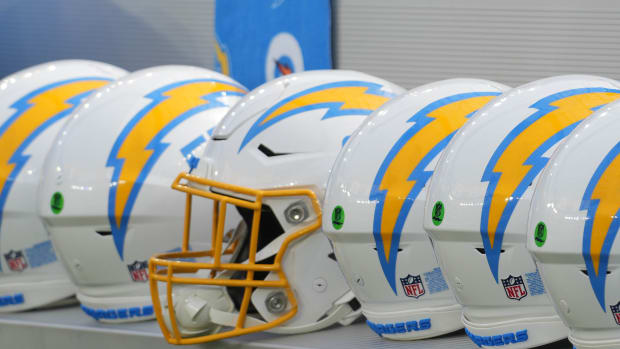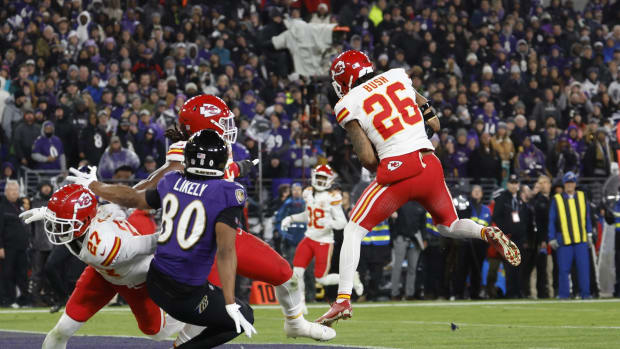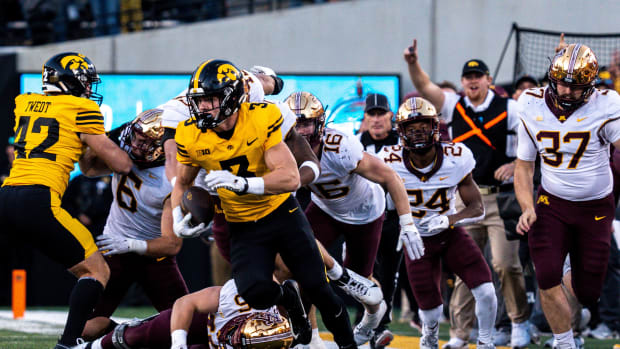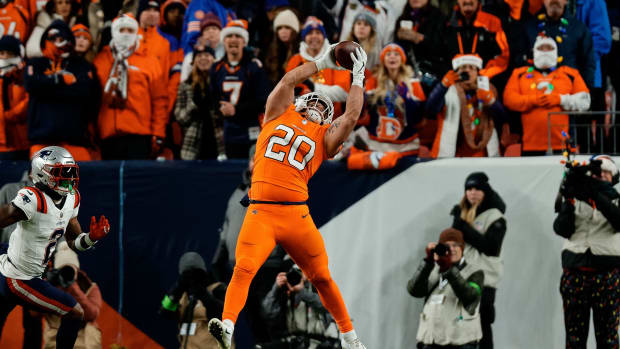
That New Motown Sound
Reggie Bush has been instrumental in the diversification of the Lions offense this season. (Paul Sancya/AP)
The Lions offense in recent years had mastered the art of posting big but empty numbers. Last year, the Lions ranked third in yards per game but just 17th in points, finishing with a 4-12 record. In 2011, they were fifth in yards and fourth in points, but the offense was not quite strong enough down the stretch to carry a collapsing defense. After a 5-0 start, the 2011 Lions lost seven of their last 12 (including a first-round playoff game at New Orleans).
The Lions 2013 preview here on The MMQB emphasized the offense’s need to sophisticate its high-powered attack. So far this season, head coach Jim Schwartz and, more specifically, coordinator Scott Linehan have done that. A disappointing last-second home loss to the Bengals recently dropped the Lions to 4-3, but that still leaves them near the top of the injury-ravaged NFC North.
Let’s examine why the Lions’ updated offense is one of the most intriguing (and still prolific) in football. It starts with the most important free agent signing of this past offseason.
Part I: The Bush Factor
Reggie Bush made a great point in a production meeting with CBS’s Marv Albert and Rich Gannon prior to the Bengals game last week. The eighth-year veteran said that, as a Saint, he was used just a tad too much in the passing game and not quite enough in the running game. As a Dolphin, he was used a bit too much in the running game and not quite enough in the passing game. Bush feels that his role as a Lion is perfectly balanced (98 carries so far, 32 receiving targets).
Since his arrival, the Lions have finally committed to a foundational ground game, running the ball on 53 percent of their first-down snaps this season (third most attempts in the NFL). Last year, they ran on just 45 percent of their first downs. The year before, 43.5 percent.
A bulk of these first down runs have featured Bush between the tackles. Overall, the results have been hit or miss. The Lions have moved the chains a league-leading 15 times on such carries, as Bush has a sense for hitting the downhill throttle when he’s afforded clear initial spacing. However, Bush also has a proclivity to dance in the backfield when his rushing lanes look murky.
But even when those lanes are continuously murky—like they’ve been the last two weeks with Detroit’s offensive line unable to generate much push against the stauncher defensive fronts of Cleveland and Cincinnati—Linehan has remained committed to balance on the ground. That has compelled defenses to stay honest, which has empowered the Lions’ play-action game and kept them in more manageable third downs.
Of course, Bush’s main value is in the passing game, where he’s not just a lethal threat out of the backfield (screens, swing passes, even handoffs from spread sets) but a movable chess piece that Linehan can use to dictate matchups from the slot or split out wide.
This increased flexibility is not the only change Bush has brought forth. Some of his best work as a decoy has come off presnap motion. The Lions, who normally prefer static formations, have made a point to use these new wrinkles early in games.
Part II: The Megatron Factor
Bush never played with a receiver in Miami who regularly commanded safety help over the top. In fact, he never really played with this sort of receiver in New Orleans, either. Now, playing with Calvin Johnson, Bush has the luxury of consistently facing just seven, and sometimes even six, defenders in the box, as described in the graphics above. Lateral agility and willingness (or eagerness) to redirect and change field makes him the perfect type of runner for exploiting a soft box. We saw this fully illustrated against the Bears a few weeks ago.
Johnson this year has not aligned only in wide splits like you see above. The Lions last season started moving the 6-5 dynamo to the slot more (28 percent of the time, according to Pro Football Focus), where he is more difficult to double team. They have continued that this season, with Johnson kicking inside 26 percent of the time, occasionally even off an uncommon presnap motion (like on his 27-yard touchdown last Sunday).
More than the newfound formation versatility, the Lions have diversified their passing game with an influx of quick-timing routes. Johnson’s two touchdowns last week were his first two 20-plus-yard catches this season. He is much more of an underneath threat—which the numbers attest to. According to PFF, 61 percent of Johnson’s catches have been within 10 yards of the line of scrimmage. Last season, it was 51 percent.
Obviously, Johnson still runs plenty of deep routes—there isn’t a better coverage-lifting decoy in the NFL—but he’s very much a part of a Lions’ passing game that, as a whole, has contracted in order to help Stafford get the ball out quicker. Stafford, in response, is having a career year.
Part III: Matthew Stafford
A quicker passing game would not work without Stafford’s improvements in the presnap phase. He has been sharper at identifying defensive fronts and coverages, plus he’s had better discipline to take what’s available early in the down. The cannon-armed 25-year-old will always have a gun-slinging style of play. Consequently, he’ll always have big-time playmaking ability but also inherent bouts of inconsistency. But no longer are Stafford’s bouts of inconsistency compromising the flow of Detroit’s offense. They’re less frequent and shorter-lived. In fact, his trademark gambles—most notably his throws from weird arm angles when under duress—have been positives more often than not.
The quicker, sharper passing game has also allowed Detroit’s somewhat modest front five to survive soundly in pass protection. And it has helped accelerate Stafford’s chemistry-building process with receivers Kris Durham, Ryan Broyles and Joseph Fauria, all of whom have bigger-than-expected roles thanks to injuries at their position.
Facing Dallas
The Cowboys front four has been rocked by injuries, but high-effort backups like George Selvie, Drake Nevis and Nick Hayden have overachieved in elevated roles. More importantly, the Cowboys secondary has been outstanding in press coverage on the outside (which they play the vast majority of the time, as Monte Kiffin has substituted his “Tampa 2” for a Seahawks-style hybrid press scheme). The Cowboys linebacking unit—or, really, Sean Lee—has played with speed and discipline in all phases.
Style-wise, this could be Detroit’s most challenging foe yet. Lee matches up well to Bush, while cornerback Brandon Carr has the size and flexibility to spar with Johnson. The Lions will have to lean on their ancillary weapons. Fortunately, they’ve designed their system around Bush and Johnson in ways that make that easy to do.
Thursday Night Preview
The loss of Doug Martin will hurt Mike Glennon, who has been surprisingly poised as a rookie third-rounder. (Andrew Snook/Icon SMI)
Buccaneers offense vs. Panthers defense
One thing—or maybe THE one thing—that Bucs fans can be encouraged about is the play of Mike Glennon. Aside from a handful of typical rookie misreads, the third-rounder has been uncommonly poised in a vertically inclined passing system that demands he hang in the pocket. Glennon has all the instincts and tools of a classic dropback quarterback. Style-wise, there are similarities to Joe Flacco. (That is, when Glennon isn’t throwing deep; he must significantly improve his downfield accuracy, especially outside the numbers.)
We’ll see if Glennon can remain poised now that the opposing defense don’t have to worry much about the run. The likely absence of Doug Martin hurts. With good help from lead-blocking fullback Erik Lorig, this front five can still be decent enough to give rookie Mike James consistent shots at success. More likely, though, the Bucs will have to expand their aerial attack. Carolina’s speedy linebacking corps is tough to run against.
Carolina’s secondary can be exploited, but only if the dynamic front four it plays behind can be contained. Defensive end Greg Hardy (who also plays inside on some passing downs) might be the biggest breakout star of 2013. (Not that he wasn’t an emerging player before this contract year.) The Bucs’ pass protection has improved over the past two weeks, thanks in part to the team’s willingness to keep extra backs and tight ends in to help. Max protection is pretty much mandatory given the downfield nature of this passing game.
Panthers offense vs. Buccaneers defense
Cam Newton has completed 76.9 and 88.2 percent of his passes over the last two weeks, lifting Carolina back to .500 and applying some much-needed coolants to head coach Ron Rivera’s seat. Carolina’s last two opponents, Minnesota and St. Louis, both play very standard zone-based defense. It just so happens, that’s exactly what Tampa Bay generally plays.
The Bucs’ zones, however, are stocked with better defensive backs than Newton has seen lately. Even though Darrelle Revis is not playing a lot of man, he’ll likely follow Steve Smith around. That means there will be instances that require Newton to go deeper into his progressions and look for ancillary, or even dump-off, targets. Those are usually the situations where Newton becomes undisciplined and mistake-prone.









































